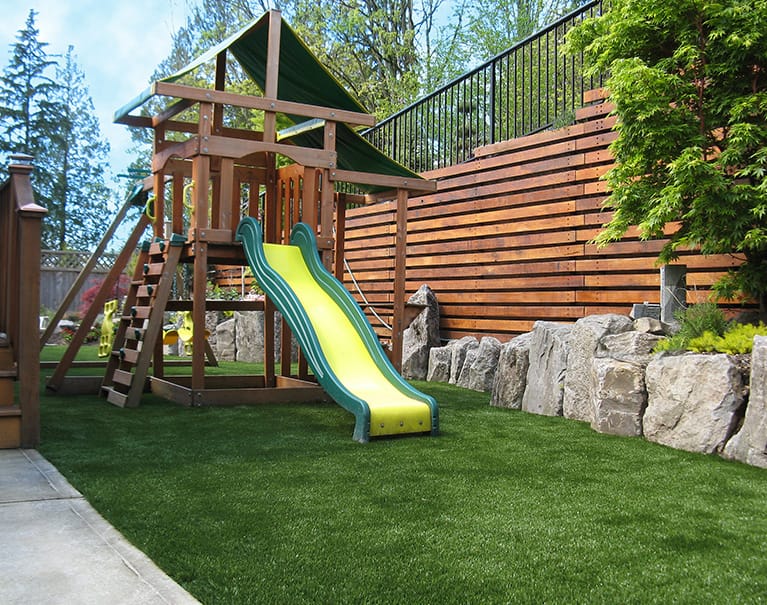Recognizing Just How Synthetic Grass Works for Your Home and Yard
Synthetic grass has emerged as a useful option for property owners seeking to improve their outdoor spaces without the problems of standard yard maintenance. The implications of choosing artificial lawn expand past plain look; they touch upon ecological considerations and lasting sustainability.
Benefits of Synthetic Grass
Recognizing the growing popularity of artificial lawn, it is essential to discover its many advantages. Unlike all-natural grass, synthetic grass does not require mowing, watering, or fertilizing, which converts to time and expense savings for house owners.
Additionally, synthetic grass offers a lush and continually environment-friendly look throughout the year, despite climate conditions. This visual appeal boosts the visual high quality of any landscape, making it an appealing selection for houses. Additionally, synthetic turf is sturdy and made to withstand hefty foot website traffic, making it an ideal service for family members with pets and kids.
Safety is an additional crucial consideration; contemporary fabricated grass is commonly made from non-toxic materials and includes shock-absorbing technologies, decreasing the threat of injuries during play. Fabricated turf is immune to weeds and bugs, getting rid of the requirement for chemical treatments, consequently promoting a much healthier outside environment. Overall, the benefits of artificial lawn make it a compelling option for improving home and garden rooms.
Setup Process Introduction
When taking into consideration the installation of synthetic grass, a systematic approach is vital to make sure ideal results. The setup procedure normally starts with comprehensive site preparation, which involves getting rid of the location of any existing yard, debris, and rocks. This action is essential for establishing a secure and degree structure.
Following, it is necessary to examine the water drainage capabilities of the location. Proper water drainage is vital to prevent water pooling externally, which could lead to early wear or problems with mold. This might need excavation and the installation of a water drainage system if required.
As soon as the site is prepared, a base layer is set up, generally including crushed stone or disintegrated granite, compacted to produce a solid surface. After achieving a smooth base, a geotextile fabric is laid down to inhibit weed growth.
The last stage involves laying the synthetic grass itself. The turf rolls are placed, cut to fit, and secured at the seams utilizing specific or glue grass tape. Ultimately, infill materials might be put on enhance security and enhance the overall look. Properly following these actions will certainly cause a sturdy and visually pleasing synthetic grass installment.
Sorts Of Synthetic Grass

Among the key classifications is domestic lawn, which is usually used in yards, backyards, and play locations. This type commonly features a soft appearance, making it risk-free for kids and animals. Business lawn, on the other hand, is engineered for high-traffic areas, such as sports areas and metropolitan parks. It offers toughness and durability, guaranteeing it endures extensive use while maintaining its look.
One more classification consists of landscape lawn, which resembles all-natural yard very closely to boost the aesthetic allure of gardens and outdoor rooms. Additionally, placing eco-friendly grass is particularly developed for golf lovers, including a much shorter pile elevation and a smooth surface for an optimum placing experience.
Finally, pet-friendly turf integrates antimicrobial buildings and why not look here durable materials to ensure a hygienic and risk-free setting for pets. Selecting the right sort of synthetic grass is crucial for accomplishing the designated look and capability in your house and yard.
Maintenance Demands
Correct maintenance is important for prolonging the lifespan and look of artificial turf. Regular maintenance not only improves aesthetic appeal but additionally makes sure optimal efficiency. The main maintenance jobs consist of brushing, washing, and evaluating the turf.

Rinsing the turf with water helps remove dust, debris, and pet waste. Utilizing a pipe with a spray nozzle makes this task efficient and reliable. In locations prone to heavy rainfall, guarantee correct drainage to avoid merging.
Additionally, routine evaluations for damages, such as tears or loosened joints, are essential. Timely repairs can avoid more significant problems and maintain the stability of the grass. By adhering to these maintenance needs, house owners can appreciate the elegance and functionality of their fabricated lawn for years to come, making certain a dynamic and inviting outdoor area.
Ecological Factors To Consider
Synthetic turf presents a complex selection of ecological factors to consider that require cautious assessment. Arizona artificial look at this now grass. While it decreases the need for water, fertilizers, and chemicals, which are normally connected with natural grass maintenance, there are substantial issues regarding its production, disposal, and use
The manufacturing of artificial grass includes petroleum-based products, questioning about fossil fuel usage and greenhouse gas exhausts. Moreover, the installation process typically needs a layer of infill, regularly composed of materials like crumb rubber, which can release hazardous chemicals right into the environment.

Disposal of synthetic grass presents an additional challenge, as it is not naturally degradable and can contribute to landfill waste. Some reusing options exist, but they are not commonly readily available or available.
Conclusion
In summary, fabricated lawn provides countless advantages for domestic and garden applications, consisting of aesthetic appeal, reduced maintenance, and safety and security for pet dogs and youngsters. Numerous types of man-made lawn cater to various requirements and choices, while environmental considerations highlight its prospective sustainability benefits.
In general, the benefits of fabricated lawn make it a compelling alternative for boosting home and yard spaces.
When considering important site the setup of synthetic grass, an organized strategy is vital to guarantee ideal results. The turf rolls are positioned, reduced to fit, and protected at the joints using adhesive or specialized grass tape. Properly adhering to these actions will certainly result in a resilient and visually pleasing synthetic lawn setup.
In recap, man-made turf offers numerous benefits for household and garden applications, including visual appeal, reduced maintenance, and safety for animals and children.